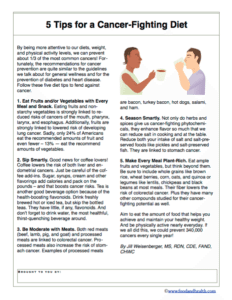Handout: 5 Tips for a Cancer-Fighting Eating Pattern
By being more attentive to our diets, weight, and physical activity levels, we can prevent about 1/3 of the most common cancers! Fortunately, the recommendations for cancer prevention are quite similar to the guidelines we talk about for general wellness and for the prevention of diabetes and heart disease. Follow these five diet tips to fend against cancer.1. Eat Fruits and/or Vegetables with Every Meal and Snack. Eating fruits and non-starchy vegetables is strongly linked to reduced risks of cancers of the mouth, pharynx, larynx, and esophagus. Additionally, fruits are strongly linked to lowered risk of developing lung cancer. Sadly, only 24% of Americans eat the recommended amounts of fruit and even fewer – 13% — eat the recommend amounts of vegetables.2. Sip Smartly. Good news for coffee lovers! Coffee lowers the risk of both liver and endometrial cancers. Just be careful of the coffee add-ins. Sugar, syrups, cream and other flavorings add calories and pack on the pounds – and that boosts cancer risks. Tea is another good beverage option because of the health-boosting flavonoids. Drink freshly brewed hot or iced tea, but skip the bottled teas. They have little, if any, flavonoids. And don’t forget to drink water, the most healthful, thirst-quenching beverage around.3. Be Moderate with Meats. Both red meats (beef, lamb, pig, and goat) and processed meats are linked to colorectal cancer. Processed meats also increase the risk of stomach cancer. Examples of processed meats are bacon, turkey bacon, hot dogs, salami, and ham.4. Season Smartly. Not only do herbs and spices give us cancer-fighting phytochemicals, they enhance flavor so much that we can reduce salt in cooking and at the table. Reduce both your intake of salt and salt-preserved foods like pickles and salt-preserved fish. They are linked to stomach cancer.5. Make Every Meal Plant-Rich. Eat ample fruits and vegetables, but think beyond them. Be sure to include whole grains like brown rice, wheat berries, corn, oats, and quinoa or legumes like lentils, chickpeas and black beans at most meals. Their fiber lowers the risk of colorectal cancer. Plus they have many other compounds studied for their cancer-fighting potential as well.Aim to eat the amount of food that helps you achieve and maintain your healthy weight, and be physically active nearly every day. If we all did this, we could prevent 340,000 cancers every single year!By Jill Weisenberger, MS, RDN, CDE, FAND, CHWCSo without further ado, here's 5 Tips for a Cancer-Fighting Diet by Jill Weisenberger, MS, RDN, CDE, FAND, CHWC. To get more handouts like this (6 new ones every month, in fact, with seasonal recipes and fantastic fact sheets) become a Food and Health member today!Don't miss these fantastic materials from the Nutrition Education Store...[shopify embed_type="product" shop="nutrition-education-store.myshopify.com" product_handle="diabetes-and-cancer-link-powerpoint-and-handout-set" show="all"][shopify embed_type="product" shop="nutrition-education-store.myshopify.com" product_handle="freedom-from-chronic-disease-poster-fruit-and-vegetable-promotion-with-statue-of-liberty" show="all"][shopify embed_type="product" shop="nutrition-education-store.myshopify.com" product_handle="diet-and-breast-cancer-powerpoint-and-handout-lesson" show="all"]
To get more handouts like this (6 new ones every month, in fact, with seasonal recipes and fantastic fact sheets) become a Food and Health member today!Don't miss these fantastic materials from the Nutrition Education Store...[shopify embed_type="product" shop="nutrition-education-store.myshopify.com" product_handle="diabetes-and-cancer-link-powerpoint-and-handout-set" show="all"][shopify embed_type="product" shop="nutrition-education-store.myshopify.com" product_handle="freedom-from-chronic-disease-poster-fruit-and-vegetable-promotion-with-statue-of-liberty" show="all"][shopify embed_type="product" shop="nutrition-education-store.myshopify.com" product_handle="diet-and-breast-cancer-powerpoint-and-handout-lesson" show="all"]


